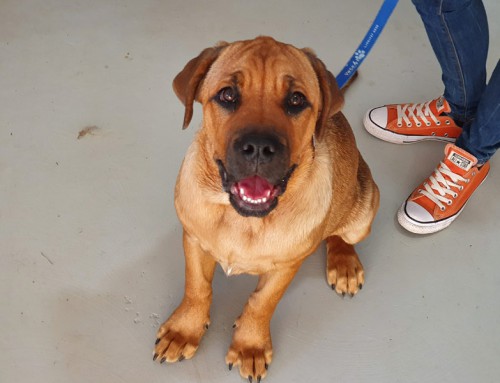You’re about to bring a new kitten home, and you and your family are so excited. There’s only one small problem… you’re a little worried about how your dog is going to take to this new arrival!
Bringing a new animal, be it a kitten, a cat or another dog, into a household which already has a resident dog can create stress all round. However, there are ways to effectively minimise that stress and help your pets to get along together.
Here’s our tips on how to introduce a kitten to a dog, without causing too much friction.
1. Prepare your dog for the new arrival
Even if your dog has lived with other animals before, they still may not take kindly to a new pet coming into their territory. While you may think they’re going to get along just fine, you can never be sure what will happen.
Therefore, make a point of giving your dog lots of attention and praise when you bring your new kitten home, to show that they’re not going to be a threat to your affection. And remember; dogs can very easily hurt or even kill a kitten, so never leave them alone together in those early days.
2. Prepare a room for your new kitten
Getting to know a new kitten can be tricky, with or without the added issue of existing pets. One of the best ways to make your new arrival feel at home is to prepare a safe space for them, preferably their own room if that’s possible. Put a bed, a litter box, and food and water into the space, and then leave the kitten alone to explore. You may want to keep your kitten completely separate from your dog until it’s had chance to get to know you first.
3. Let them get used to each other’s scents
If possible, try to feed your kitten and dog on either side of a door, so that they can smell each other before meeting face to face. Your dog shouldn’t be allowed to whine, scratch or bark at the door, as this can be very intimidating for your new arrival.
Another way to introduce the animals to each other is to swap their blankets or a put a towels with their scents on it in each other’s bed. This will help them pick up the scent and become comfortable around it before coming into contact. You can also introduce each animal to the other’s space (when they’re not there), and let them have a good sniff. Just remember not to let your dog eat your kitten’s food or scratch in their litter box.
4. Meeting for the first time
When it’s time for your kitten and dog to meet for the first time, keep your cat in their box and put your dog on a leash. This way they can see each other without any physical contact taking place. Make your dog sit, and be prepared to take him or her out of the room if they get too excited. This activity should be repeated until both animals can relax when together. Don’t forget to reward both of them for their good behaviour by giving them lots of praise and cuddles.
5. Moving on
Once your pets are comfortable being together in the same room, it’s time to let your cat out of the box. At this point, you should still keep your dog on its leash. If your cat seems reluctant to come out coax them with a treat, however don’t try to force it. Once out of the box, let the kitten explore, keeping your dog at your side. This should be repeated several times a day, until your dog is able to relax when the kitten is exploring.
6. Letting your dog off the leash
When you get to the point where your dog can remain calm while your kitten is in the room, it’s time to let them off the lead. Getting to this stage can sometimes take weeks, so don’t worry if it seems to be taking longer than you expected. If you leave your pets home alone during the day, it may be best to keep them separated until your kitten is a full-grown cat, particularly if you have a dog that sees everything as ‘prey’.
7. Don’t force it, and remember to take things slowly
Introducing new pets to each other will always take longer than you think, so don’t try and force the issue. The key to successfully introducing a new kitten to your dog is to take it very slowly. If your dog is struggling to relax around your cat, it’s advisable to keep them separated by a physical barrier when you’re not there to monitor the situation. Better to be safe than sorry!







These are very helpful! However I’m not quite sure how to introduce my dog to several kittens (I have three). Should I introduce them all at once or one by one?
Oh that’s tricky! I think I would start one by one, to be on the safe side!
I have a 1.5year old corgi and just got my daughter a Maine Coin kitten. How should I introduce them..like things you said above?
i have an 11 year old female pomeranian and i’m getting a kitten in two weeks. i’ve never had any other pets before. should i follow the steps listed above or is there anything i should do differently
I have 14 year shitzu. He is jealous. Each day we take the two kittens out to play in common area of home. I have been keeping my dog on leash. I have a 14 year old cat too. Whrn the kittens are full grown I will feel much better.
I have an English bulldog that mostly lives inside. I allowed him to smell the kitty when we brought it home then put him outside til the kitty got comfortable. I waited awhile and let him back in for the night. I’m aftaid when the kitty wakes up and maybe comes out of hiding or meows. I dont want him feeling punished by leaving him outside but don’t want the kitten to hide because he’s scared.
Hi Renee, yes that is a difficult situation. I would suggest you ask your vet the best way to proceed. Regards, Liz
Hi. I had a cat for 12 years. We got a puppy maltese and they were getting along well. I mean, the cat was the boss and at first my dog was all annoying to a cat but he eventually figured that the cat doesn’t care or wants to play. My cat was allowed inside/outside so there was no problem if the dog was very annoying, the cat would simply get out and come back later. Anyway, my kitty died few years back and we are thinking about adopting a new, small kitten. So my question is, will my dog remember how to behave around cat living with us or he will be bossy because now he is the only pet and needs to get used to a new pet.
I think it would be good to ask your vet this question. Your vet will know the history and personality of your dog.
I just got a kitten 3 days ago and I have a 99 pound dog the dog seem’s interested in the kitten but the cat doesn’t like the dog at all and hisses at her. And the cat has adjusted all ready to the house. Any advice you have for me to get the cat to get along with the dog?
Hi Trinity, have a chat with your vet. I am sure they can give you good advice. Cheers, Liz
I have a 2 yr old Rottweiler and just got a Kitten today . I kept the kitten in the carrier for an hour on return and I have a huge dog crate under my stairs space which is fab as they can both smell each other face to face with a small barrier at least. So far so good today all is well I will let her out in a few weeks once I know they’ll both Be ok without a cage and just dog lead between them . Both have slept which is good no one is anxious . I hope this helps .
Hi the tricks u mentioned are very helpful I have 2 female german shepherds and I’m scared that even if my dogs are relaxed when my new kitten is exporing the new surroundings, my dogs hate cats so they my try to hurt him when I’m not around . My dogs see everything that’s moves as prey .
If you know that your dogs treat any animal like prey, why in God’s name would you bring a kitten into your home?
I have a German Shepard as well and frequently they won’t hurt babies no matter what kind of baby it is. Make it clear that it is part of the pack and you expect them to protect the baby kitty.. I’m currently going through the same thing and he is doing pretty good. Lots of praise and a kennel for the kitty so they can smell each other but she is safe. Don’t turn your back on your pups until they have fully accepted the kitten.
Hey my 10 week old kitten and I have had to move in with my family and my mum has a greyhound cross wolf hound, we have done all the steps but my kitten just doesn’t seem to like the dog and my kitten is picking fights with the dog. The dog doesn’t care until the kitten starts hissing at her just wants to smell her.
We were living with two dogs before we moved and she was fine with them. My kitten is fine with the other dog at my mum’s place so I don’t know what to do, can you please tell me what to do about it?
Hi Serena, I would definitely speak to your vet about how best to manage this situation. Warm regards, Liz
Hey I have an old rescue dog who has never been friendly towards other animals. My sister is moving back in and has a kitten and I was wondering do you think it’s possible for the my dog to adjust or would it be best to re-home the kitten? Thank you!
I suggest you discuss this with your vet who can give you advice on the best way to approach integration.
Looking for advice. So my dog has no issues with cats and is okay being around them. I want to get him a friend that will play with him so thinking a kitten. But I dont want one that wont pay him any mind. Is there any way to kno if a cat will like and play with dogs before getting one?
Hi Meagan, This is really something that you have to discuss with your vet or where you get your kitten from, their breed, their age, and their past experiences. Liz
I have a stray mother cat and her two kittens who were born in my house. I also have a Bernese mountain dog (130 lbs). I have kept them separated and the kittens are now 11 weeks old. The dog is used to living with adult cats and is very gentle with them. I would like to introduce the mother cat and the kittens to the dog but am worried about the mother cat’s reaction. Any suggestions?
Hello Mary Ellen, every situation is unique. I would suggest you take it slowly and gently and ensure that there is supervision. Maybe start with introducing the cat to the dog where they are separate, but can see each other and gauge her response from that safe encounter. Given that she is a stray, how she will react would be influenced by her past experiences, which we do not know about, so we cannot predict how she may react. Give her lots of encouragement as well, of course.
Don’t ask Liz any questions, just ask your vet.. like your vet knows your cats personality from the 10 minutes he or she spends with your cat once or twice a year. It seems like Liz wrote a article compiled from info around the internet but other than that she doesn’t know anything about cats.
That’s right Amy. It would be irresponsible to provide advice on a specific situation, so I would always suggest a visit to a vet, trainer, behaviourist, or other specialist when there are specific issues. Sometimes the issues can be more complex that they appear, and advice needs to take in a range of factors.
Ha ha..great. I love that you said exactly what I was thinking Amy, after reading her repeated comments stating “talk to your vet”. It’s like, Don’t write an article about something you have no clue about or able to answer questions that will arise from it.
Hi Pet Lover, it would be irresponsible for us to give advice without knowing or seeing the pet.
Good one I was thinking same thing about asking Liz anything it’s the same answer ask your vet. So don’t ask Liz should be the advice hear.
With respect Lisa, it would be unwise to give advice when little is known about the individual situation. So yes, dont ask Liz, ask your vet.
I have 3 small dogs over the age of 10, 2 females and a male. I am getting a small kitten and I am sure the females will be fine with the new kitten. On the other hand the male (who is 12 years old) is always aggressive with other animals(he is small and has very few teeth but he tries) as a matter of fact he is always bullying the younger of the 2 females. All 3 of the dogs stay in the entry way of my home , gated off from the rest of the house ,that has a doggy door so they can go in and outside. I plan on keeping the kitten in a separate room with all of her necessities during the day while I am at work. I just am not sure how to introduce her to the dogs without causing too much anxiety for anyone.
Hi Carol, I would discuss this with a dog trainer. Every case is different! Kind regards, Liz
Hi Liz I am curious if its possible to have 2 boxers (girls) to use to a 11 week old kitten. My plan is to get the dogs use to the meowing and teach them to be clam during the meowing on my phone. Then my next step is to put the baby gate up and introduce the cat to dogs one at a time. Then lastly bring the cat over the fence. Could possibly give me any tips and trick for them to get use the kitten. I only have a week to prove to my dad mom that my dogs can use to cats.
Hi Trinity, every case is different! It sounds like you have a good plan, but it would be worth getting in touch with a pet specialist who trains dogs to give you some ideas! Good luck! Liz
I have a 21/2 year old dog who wants to attack my 2kittens what can I do to get him to like the. New kittens
Hi Lisa, I think it would be good to consult a professional dog trainer to give you personalised advice. Each circumstance is different. Liz
I have a 4 year old German shepherd he’s not to friendly so my daughter got me as a gift a 6 weeks old kitty and my shepherd is crying and wanting to smell the kitty but in a anxious way I’m not sure what to do he try to bite him when he was inside the kennel ♀️
My roommate just got 2 kittens about a month ago, but she keeps them secluded and won’t let them explore out 9f her room mongo anywhere near my puppy. They have onlyn interacted twice and thr kittens are getting bigger. Could this lead to issues? We already have one cat that is very mean to my puppy, I don’t want 2 more
Hi David, every situation is different so cant really tell you with certainly whether issues could emerge. I would encourage some contact, in a safe environment. In other words where you can keep your eye on them and observe how they interact. Doing things slowly and calmly is best, giving time for adjustment.
I have introduced my 9 week old kitten to my dog several times.. Holding the kitten in a blanket. He has jumped up several times but also has sniffed her.. He hasn’t barked or growled just sniffing her.. He even licked her.. Been doing this for a few days now.. Do u think this a good sign
Hi Patricia, certainly sounds promising. Important to play it safe!
Hi it’s my kitten seems to be the problem. I look after my mums 8mth old shih tzu and she is fine just wants to play and wags her tail. I keep her on lead but kitten seems very aggressive and wants to hiss and paw at her is this normal?
Hi Paula, I would ask that question to your vet who would be more familiar with your situation.
Hi my son has just bought a 10 week old ragdoll Male kitten we already have a wee cross shitzu westie and she loves playing with cats but the kitten keeps hissing and spitting at my wee dog how do we get round this thanks
Hi Sandra, I suggest it would be good to speak to your vet to get some advice.
I have a cat who’s 4 and my dog who’s 3 they’ve been around each other since he was 4 months , we just got my daughter a kitten and hes ( my dog ) so nervous around him like trembling nervous when hes in the kennel, my daughter went all willy nilly and was letting him out as soon as we brought him home and naturally the dog came to sniff and got wacked on the nose with a paw that has claws which hes never felt and did not like so he went at him in a not so nice way , I’m afraid hes going to end up hurting the kitten any other tios on helping , right now kitty lives in mybdaughters room we just brought him home a night ago.
Hi Tiffany, that’s a tricky one. Maybe best to consult with your vet who is familiar with the cat and dog? Liz
I have an outside dog (pitbull) he is sweet, but has not been around other animals much aside from the dog next door. The dog comes in the house and hangs out with the family but he is still an outside dog. I just got a kitten and I am wondering if I should put the kitten in a room when the dog comes inside. He has caught on to the scent of the kitten and has been wanting to come inside and cries. I am just a little scared that he would let his natural instincts take over and hurt the kitten. Should I seek professional help?
Definitely seek professional help Ed, Liz
I have kittens/cats all my life. My last one passed away a year ago. We also had a German Shepherd dog who also passed away. Since we have gotten another GSD. She is 10 months old. I really really miss my kitties:cats and want another. Is it best to wait until the dog is older or do it while she is young.
I have a 13 year old dog we is very protective. If anyother animal come he barks. He is a small dog and dosnt bite but barks alot. I am thinking about getting a kitten. Would this work?
Jayden very difficult to know this. I suggest you consult your vet or dog trainer. Regards, Liz
Hi. I have a 4 year old Labrador who is very exited. I just got a kitten and i am starting sent swapping. My dog gets really hiper around other animals. She just wants to play but I’m afraid she might hurt the kitten???? Please help.
Hi Simone, I suggest you talk with your vet or an animal trainer / behaviourist to get assistance. Regards, Liz
Hi,
Just wondering if it’s normal for a 7yr old female dog who is neutered to cover my bed in urine since I got a female kitten a few days ago? She has NEVER done this before so I assume it’s related. The dogs sleeps on the bed at night with me and the kitten is in her crate in the loungeroom. The dog is fine with cat altogether, falling asleep on her, next to her and even licks her…so I’m confused. They do cuddle up on the bed when the kitten is out of her crate for freetime. I’m currently retraining my dog with her own crate but so angry she has basically ruined all my bedding. Thanks in advance!
Hi Rachel, I suggest you talk with your vet or an animal trainer / behaviourist to get assistance. Pet’s sometimes do strange things, but there is generally an explanation and a solution! Regards, Liz
My dog never peed in the house. Now we have a kitten our female Chihuahua has peed twice in the kittens room. HELP!!!
Oh boy! I suggest you call a behaviourist to find out what’s going on here – but it definitely sounds like marking territory! Good luck! Liz
Thanks for the great tips. I’ve been lucky, when introducing new cats, dogs and kittens. They were all a bit anxious at first, then within a few days, they got along great.
Glad you found the info helpful Tara!
We found a barn kitten in our truck, we decided we are going to keep it. We have a 4 year old Rottweiler who is spoiled beyond belief and needs to be the center of our attention all the time, we also have a 3 year old Pyrendoodle (Great Pyrenees/ & Standard Poodle ) my Rottie has been around cats for about 1 .2 years before our cat died and was always good with it. Our Pyrendoodle seems to have a high prey drive. How do we get her not to think she can attack or hunt the kitten?
Hi, we lost our beautiful cat only a week ago she was my dogs best friend. My dogs although large are so gentle and loving of cats, my last was only 3 weeks old when we found her, the dogs looked after her, protected her and taught her love. We just rescued a kitten thats 12 weeks old and she is terrified of the dogs. The dogs are so calm, how to I help to calm the kitten?
Hi Rachel, this post might be of use but I would also suggest chatting to your local vet, who might be able to offer some tips.
http://www.petsecure.com.au/pet-training-tips/7-tips-to-successfully-introduce-your-kitten-to-your-dog/
What age is appropriate for a kitten when meeting a small (and generally friendly) dog? I think I should wait until the kitten is weaned of her momma cat so the decision can be entirely its own. Any tips?
I know this is a year later. But I was googling how to introduce my dogs to my new kitten. I have 4 chihuahuas. They have seen the cat when we brought ( her?) home yesterday. The cat was scared of course and I had done read up a little on the way to get the cat ( out of the blue got the cat, wasn’t planned) and I set the cat up it’s own room. Brought it out this morning, cat wasn’t scared as much of the dogs but the dogs was super excited and scared her. How do I get all the dogs to be ok with her?
I have three dogs. I just got a kitten after years of any of the dogs being around cars. My kitten HATES dogs but they love her. What’s the best way to get her comfortable?
Suggest slow acclimitisation.
I currently have a Jack Russel who has lived on her own all her life. Would it be too dangerous to introduce her to a new kitten? Would both of them still be able to have a good quality of life?
Hi Rebecca, You could guage this with a short meet and greet. But make sure you are close by to keep your kitten safe and your Jack Russel in her comfort zone. Important to remember that some dogs and cats are quite territorial which can make situations tricky.
I don’t have a cat kennel to help with the introduction any other suggestions. I have two new kittens, they have been in a room to their selves for over a week and have gotten used to my other cat. However my dog is pretty active and my other cat already doesn’t like her. I want the new kittens to accept her please help
I had a cat recently pass away due to an accidental piercing to her back by our pitbull they lived in the same house for 7 years together but we never really had them in the same room for long she mainly stayed in my bedroom i know it would be silly for me to get a new cat and have the same thing happen and just to clarify this was an accident we don’t have an aggressive dog but the situation is heartbreaking and i suffer from mental illnesses and my pervious cat was my ESA what should i do or what can i do?
That’s a sad accident. I am sorry but I cannot give personal advice this is not our field of expertise.
I liz. In my case it is more the opposite around. I have a young cat he is gonna be 1year in 2month which gonna be that same time i will get a little chihuahua puppy(Gonna be 2month) any surgestion.
I was thinking doing the same. But in my case I am more affraid the cat try to attack the dog thinkin it is a little pray
I just got a new wild kitten and i have four dogs what would be the best way to introduce them?
Hi Mark, I cannot give a personal recommendation. As the first port of call, I suggest you consult your vet for a personal recommendation.
Hi Liz. I just read your article and it looks amazing. I’ve just recently got a kitten (he’s just over 4 months) and am planning to rescue a puppy (2 months right now but will travel in to England about a month). Should I use the same steps or is it different in this situation?
i have a 5 year old pitbull usually agressive with other animals and i just got. a 12 week old magpie kitten she’s staying in my room for the first month anyway so how should i introduce them
Hi Liz, we’ve had our wheaten terrier Finnegan for six years and he is highly energetic. We also just got an eleven-week old kitten named Louie. So far we’ve taken the safe route of just keeping them on two separate floors, but when Finnegan goes outside, he sees Louie through the glass sliding doors and barks at him. What should we do?
Hi Liz,
I have a 2-month-old kitten and my housemates have an 8-year-old med size dog (who is not very nice to other animals and has killed a squirrel!). They haven’t met, but the dog keeps scratching at the door to get into the room (where the kitten will be) and whimpers/growls at night. Is there a way for them to interact or at least live in separate rooms without causing an inconvenience to the housemates at night? Do you think the dog would attack the kitten? Thanks for all the great information you provided!
Hi Liz! So we just picked up an 8 week old kitten and he saw my dog and totally freaked out. He had never seen a dog before was and was scared; this was in the process of getting him into the carrier and into the car. I was wondering if it was possible for that first impression to be permanent and that the kitten will be scared of my dog forever. I might add that my dog didn’t really react and was calm. Thank you!!
Hello liz, In my case it is more the opposite around. I have 2 small dogs chihuahua she is 1 year old and 2 years old which gonna be that same time i will got 2 kittens (Gonna be 2 months old) any surgestion.
I was thinking doing the same. But in my case I am more afraid the dogs try to attack the kittens thinkin it is a little pray.
I have a dog and cat, the cat was a year old then the dog came into the house, I had a older cat too but she kept to herself when kitten came along then dog, Olivia passed away 2 year ago, so my friend’s cat is pregnant again and when kitten’s are born in thinking of taking one, there’s only a year between dog and cat so they have always been good together, any tips on kitten coming along..?
Hi Liz, Thank you for the good information. I just brought my 2 month old kitten home today. I have an 8 year old Boxer/Pitbull, she’s a very wonderful dog, but goes after squirrels and the odd bird. She has chased cats before, so she deffinately has this prey and chase instinct about her. I am following your 7 steps, I am very conserned for my dog not being friendly with my new kitty. Do you have more suggestions?
I just got a new Maine Coon Mix kitten who is nine weeks old (he has been with us for a week.) I also already have a Labrador Retriever who is 5 years old. My dog has lived with a cat before for 2 years, (who recently passed away from cancer) but my dog was younger, and my previous cat was older by 2 years.
I am simply worried that my dog will try to be more dominate and think he is the boss since 1. He’s older, 2. he has been with my family longer. He definitely wasn’t “the boss” with my other cat and I am worried that he is going to try to take control or something like that. He has always liked being a leader.
Thanks.
Hi Liz.
I have gotten a 3 months old kitten. Brought her home and did like above. My one dog (6 years) quickly calmed down around the cage and I let the kitten out. The kitten put the dog in it’s place with a few swipes and they are ok. The other dog (1 year male- neutered) is way too excitable and growls and want to bite the kitten even inside the cage…. I have no idea what to do… will they ever get used to each other?
I found a feral kitten and, it quickly acclimated to indoor life and human affection within a couple of days. He saw my dog, when we brought him in after capture and, his reaction was no different than his reaction to people at the time. I spent a lot of time locked in the room with the kitten, getting him acclimated, while the dog laid outside the door. We waited until after his vet checkup, about 4-5 days before really introducing them. My dog is generally calm but, mistakes the kitten’s defense mode for play time. Either he hops around a bit at a distance, or he lays down bored. Either way, 3 days later and the kitten is comfortable sneaking by him but, eye contact results in defensive hissing and, my dog is beginning to lose patience, which means he is going from playful interest, to possible jealousy and dislike, after being smacked on the nose a couple of times. He hasn’t attacked yet but, last night, the look in his eyes changed and, he started baring teeth. We shut it down but… I’m feeling like this isn’t going to happen the way we want. I have an older cat and, was really hoping dog and kitten would get along. I had no expectations for my senior kitty.
One of the best and my favorite blog ever. Aala stuff and best quality.
My dog had a kitten when he was young, but now he is 14-years old, deaf and nearly blind, and i am struggling to introduce a 4-month old kitten with him. He is barking when she moves suddenly, and this causes stress to her. And most concerning, his prey drive to chase and snap at her is much higher now that he can’t hear commands/directions from me. We are giving them lots of segregated time together with baby gates, but the prey drive is still stronger than i expected and I am concerned because his behaviour isn’t changing after nearly a week.
I’m a first-time visitor to this website,I find this piece of writing to be really useful, keep it up Creating such posts
Excellent post! We will be linking to this great article on our site. Keep up the great writing.